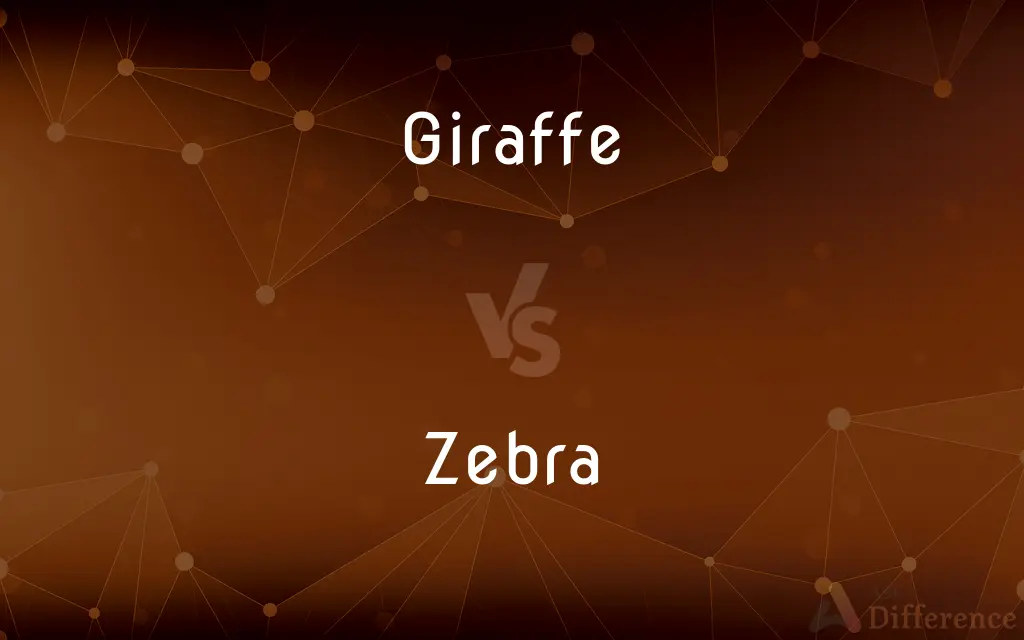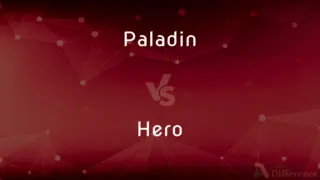Giraffe vs. Zebra — What's the Difference?
By Tayyaba Rehman & Maham Liaqat — Updated on March 30, 2024
Giraffe is the tallest land animal, recognized for its long neck and legs, and patterned coat, whereas Zebra is known for its distinctive black-and-white stripes.

Difference Between Giraffe and Zebra
Table of Contents
ADVERTISEMENT
Key Differences
The giraffe, standing as the tallest land animal, has a notable long neck and legs, adaptations that allow it to reach foliage unavailable to other herbivores. Zebras, on the other hand, are distinguished by their unique black-and-white striped coats, which serve as a defense mechanism against predators through camouflage and confusion.
Giraffes inhabit the savannas and open woodlands of Africa, where their height allows them to browse on leaves and twigs primarily from acacia trees. Zebras, whereas, are found in a variety of habitats across Africa, including grasslands, savannas, woodlands, and mountainous areas, feeding mainly on grasses.
The social structure of giraffes is quite fluid, with individuals freely joining and leaving groups, known as towers. Zebras live in more stable family groups or harems led by a single stallion, with strong social bonds, and these family groups may come together to form larger herds.
In terms of reproduction, giraffes have a gestation period of about 15 months, resulting in a single calf that can stand and walk shortly after birth. Zebras have a gestation period of approximately 12 to 14 months and also give birth to one foal at a time, which is quick to stand and run within a few hours of birth.
Conservation-wise, giraffes are classified as vulnerable, with populations decreasing due to habitat loss, poaching, and human-wildlife conflict. Zebras have varying conservation statuses depending on the species; for example, the plains zebra is relatively abundant, while the Grevy's zebra is endangered, facing similar threats.
ADVERTISEMENT
Comparison Chart
Appearance
Tallest land animal, long neck and legs, patterned coat
Distinctive black-and-white stripes
Habitat
Savannas, open woodlands in Africa
Grasslands, savannas, woodlands, mountains in Africa
Diet
Leaves and twigs, mainly from acacia trees
Mainly grasses
Social Structure
Fluid groups known as towers
Stable family groups or harems
Reproduction
15-month gestation, one calf
12-14 month gestation, one foal
Conservation Status
Vulnerable
Varies by species, from Least Concern to Endangered
Compare with Definitions
Giraffe
A tall mammal with a long neck and legs, adapted for browsing on high trees.
The giraffe stretched its neck to reach the acacia leaves.
Zebra
A wild equine known for its distinctive black-and-white striped coat.
The zebra’s stripes help it blend into the grass to evade predators.
Giraffe
Lives in loosely structured social groups.
A tower of giraffes congregated around the watering hole.
Zebra
Has a gestation period of about a year, producing one foal.
The zebra foal stood and nursed from its mother within hours of birth.
Giraffe
Known for its unique coat patterns that vary with the subspecies.
Each giraffe's coat pattern is as unique as a human's fingerprint.
Zebra
Feeds primarily on grasses in various African habitats.
Zebras grazed on the grasslands, staying close to their herd for protection.
Giraffe
Classified as vulnerable due to decreasing populations.
Conservation efforts are crucial for the survival of giraffes.
Zebra
Forms stable family groups led by a stallion.
The zebra stallion led his family group across the plain.
Giraffe
Inhabits African savannas and woodlands.
Giraffes are a common sight in the open savannas of Africa.
Zebra
Conservation status ranges from Least Concern to Endangered.
Grevy's zebra is endangered, with habitat loss being a major threat.
Giraffe
The giraffe (Giraffa) is an African artiodactyl mammal, the tallest living terrestrial animal and the largest ruminant. It is traditionally considered to be one species, Giraffa camelopardalis, with nine subspecies.
Zebra
Zebras (UK: , US: ) (subgenus Hippotigris) are African equines with distinctive black-and-white striped coats. There are three extant species: the Grévy's zebra (Equus grevyi), plains zebra (E. quagga), and the mountain zebra (E. zebra).
Giraffe
A large African mammal with a very long neck and forelegs, having a coat patterned with brown patches separated by lighter lines. It is the tallest living animal.
Zebra
Any of several swift African mammals of the genus Equus, resembling the horse and having distinctive overall markings of alternating white and black or brown stripes.
Giraffe
An African ruminant mammal (Giraffa camelopardalis) having a very long neck and legs, a tan coat with orange-brown to black blotches, and short horns. It is the tallest land animal, often reaching a height of 5 meters (16 feet).
Zebra
Any of various striped organisms, such as a zebrafish.
Giraffe
A ruminant, of the genus Giraffa, of the African savannah with long legs and highly elongated neck, which make it the tallest living animal; yellow fur patterned with dark spots, often in the form of a network; and two or more short, skin-covered horns, so-called; strictly speaking the horn-like projections are ossicones.
Zebra
A referee in football.
Giraffe
A giraffe unicycle.
Zebra
Any of three species of subgenus Hippotigris: E. grevyi, E. quagga, or E. zebra, all with black and white stripes and native to Africa.
Giraffe
(Cockney rhyming slang) A laugh.
Are you having a giraffe?!
Zebra
A referee.
Giraffe
A very tall individual.
Zebra
An unlikely diagnosis, especially for symptoms probably caused by a common ailment. (Originates in the advice often given to medical students: "when you hear hoofbeats, think of horses, not zebras".)
Giraffe
An African ruminant (Giraffa camelopardalis formerly Camelopardalis giraffa) related to the deers and antelopes, but placed in a family (Giraffidae) by itself; the camelopard. It is the tallest of quadriped animals, being sometimes twenty feet from the hoofs to the top of the head. Its neck is very long, and its fore legs are much longer than its hind legs. There are three types, having different patterns of spots on the pelt and different territories: the Reticulated Giraffe, the Masai Giraffe, and the Uganda Giraffe. Intermediate crosses are also observed.
Zebra
A biracial person, specifically one born to a member of the Sub-Saharan African race and a Caucasian.
Giraffe
Tallest living quadruped; having a spotted coat and small horns and very long neck and legs; of savannahs of tropical Africa
Zebra
(informal) A fish, the zebra cichlid.
Zebra
Any of various papilionid butterflies of the subgenus Paranticopsis of the genus Graphium, having black and white markings.
Zebra
A zebra crossing.
Zebra
Any member of three species of African wild horses remarkable for having the body white or yellowish white, and conspicuously marked with dark brown or brackish bands.
Zebra
Any of several fleet black-and-white striped African equines
Common Curiosities
How do zebra stripes benefit them?
Zebra stripes may serve several purposes, including camouflage, confusing predators, and regulating body temperature.
What adaptations allow giraffes to feed from tall trees?
Giraffes have long necks and legs that enable them to reach high foliage, primarily from acacia trees.
How do giraffes socialize?
Giraffes have a fluid social structure, with individuals joining and leaving groups without fixed bonds.
Where do giraffes live?
Giraffes live in the savannas and open woodlands of Africa.
What is the primary diet of zebras?
Zebras primarily eat grasses.
What efforts are being made to conserve giraffes?
Conservation efforts for giraffes include habitat protection, anti-poaching measures, and raising public awareness.
How long is the gestation period for a giraffe?
The gestation period for a giraffe is about 15 months.
How do giraffes and zebras reproduce?
Both giraffes and zebras give birth to one offspring at a time, which are quick to stand and become mobile.
What is the gestation period for zebras?
Zebras have a gestation period of approximately 12 to 14 months.
Why are giraffes classified as vulnerable?
Giraffes face threats from habitat loss, poaching, and human-wildlife conflict, leading to their vulnerable status.
What type of social structure do zebras have?
Zebras form stable family groups or harems, with strong social bonds, led by a single stallion.
Can giraffes and zebras be found in the same habitats?
Yes, giraffes and zebras can both be found in African savannas and sometimes share habitats.
How are zebras protected in the wild?
Zebras are protected through habitat conservation, legal protection, and efforts to mitigate human-wildlife conflict.
Are all zebra species endangered?
Zebra species vary in conservation status; the plains zebra is relatively abundant, while the Grevy's zebra and the mountain zebra are more at risk.
What distinguishes giraffes and zebras from other African mammals?
Giraffes are distinguished by their height and long necks, while zebras are unique for their black-and-white striped coats.
Share Your Discovery

Previous Comparison
Threat vs. Danger
Next Comparison
Paladin vs. HeroAuthor Spotlight
Written by
Tayyaba RehmanTayyaba Rehman is a distinguished writer, currently serving as a primary contributor to askdifference.com. As a researcher in semantics and etymology, Tayyaba's passion for the complexity of languages and their distinctions has found a perfect home on the platform. Tayyaba delves into the intricacies of language, distinguishing between commonly confused words and phrases, thereby providing clarity for readers worldwide.
Co-written by
Maham Liaqat













































